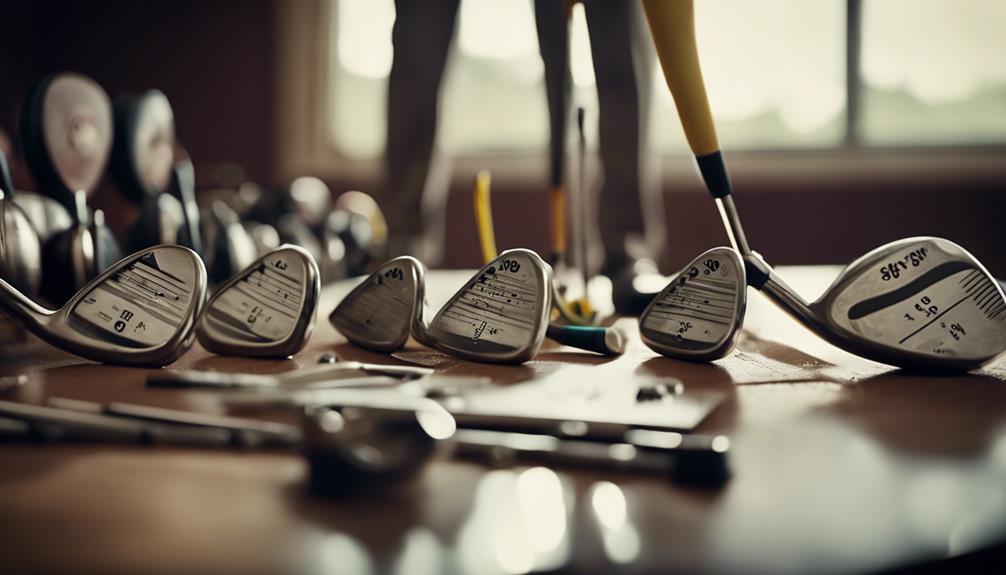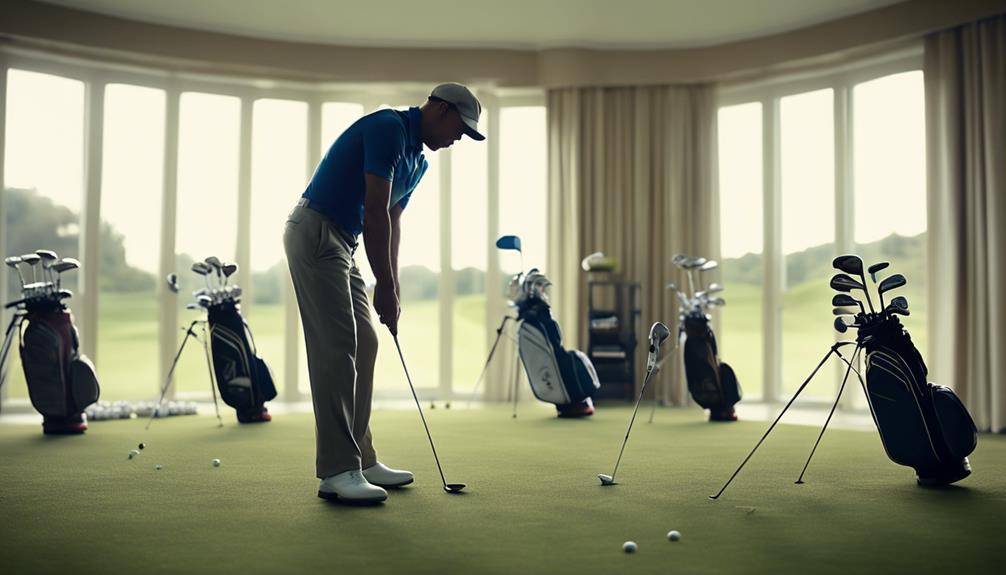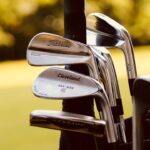- 7 Top Flite Golf Clubs XL for Improved Performance - September 28, 2024
- Top Flite Golf Clubs: Top 5 Reasons to Choose Them - September 28, 2024
- Top 3 Golf Club Fitters for a Perfect Swing - September 28, 2024
You step into a custom golf club fitting session with the goal of tapping into your full potential on the course, and the process begins with a thorough swing analysis that reveals the intricacies of your unique swing style, pinpointing areas for improvement and setting the stage for precise club fitting. This analysis, combined with measurements of your body type, swing tempo, and physical characteristics, helps determine the perfect club specifications for you. From there, you'll work with a fitter to select the right club heads, shaft flex, and grip size, fine-tuning each club to match your swing speed, tempo, and style. You're just starting to uncover the secrets of a perfectly fitted golf club – and the results could be game-changing.
Key Takeaways
- A thorough swing analysis is performed to uncover the intricacies of a golfer's swing and determine ideal club specifications.
- Measurements, including height and wrist-floor length, are taken to determine the proper angle and length of clubs.
- Club head selection involves considering factors such as sweet spot size, offset, loft angle, and draw bias to match the golfer's swing style.
- Shaft flex and weight are critical factors, with five flex options and varying weights available to cater to unique swing speeds, loads, and tempos.
- Precision fitting involves fine-tuning the length, flex, and grip of each club to ensure a consistent and accurate swing.
Understanding Your Swing Analysis
By undergoing a thorough swing analysis, you'll uncover the intricacies of your golf swing, revealing areas for improvement and paving the way for a precise club fitting.
This analysis is a vital step in custom golf club fitting, as it provides a detailed understanding of your swing characteristics.
Using advanced technology such as launch monitors and high-speed cameras, the fitter can quantify specific aspects of your club delivery and ball flight, including club head speed, launch angle, and spin rate.
This data is then used to assess your body type, swing tempo, and other physical characteristics, determining the ideal club specifications that will work in harmony with your swing.
By examining your swing analysis, you'll gain insight into your club head speed, shaft flex, and overall club delivery, allowing you to identify and correct flaws in your technique.
With this knowledge, you can optimize your equipment for improved performance, taking your game to the next level.
Measuring for Custom Fit
With your swing analysis in hand, you're ready to take the next step in the custom fitting process: measuring your physical characteristics to determine the ideal club specifications that will work in harmony with your unique swing.
To get started, you'll need to measure your height from the top of your head to the bottom of your feet, making sure to stand up straight for accurate measurements. This will help determine the proper angle for your clubs.
Next, measure your wrist-floor length by standing straight and letting your arms hang loosely at your sides, then measuring from the top of your wrist to the floor. This will give you an accurate reading for club length.
Both height and wrist-floor measurements are essential before heading to the store to talk to a club fitter. You can even use online resources to determine the correct club length based on your height and weight.
Selecting the Right Club Heads

Determine the ideal club head for your game by considering the tradeoffs between forgiveness, control, and workability. Larger sweet spots provide more forgiveness, while smaller heads offer more workability. Club head size and shape depend on your swing and desired control.
| Club Head Characteristic | Forgiveness | Control | Workability |
|---|---|---|---|
| Larger Sweet Spot | High | Medium | Low |
| Offset | High | Medium | Low |
| Loft Angle (8-14 degrees) | Medium | High | Medium |
| Draw Bias | High | Medium | Low |
When selecting club heads, consider your swing speed and ball strike to determine the ideal loft angle. Most club manufacturers offer custom clubs with varying loft angles to accommodate different swing speeds. Additionally, offset in club heads helps square the face at impact, promoting a draw shot and reducing slicing. Draw bias is also available in most drivers to reduce misses to the right and provide a more consistent ball flight. By understanding the tradeoffs between forgiveness, control, and workability, you can choose the right club heads for your game and improve your overall performance.
Shaft Flex and Club Weight
As you consider the perfect club, you'll need to think about shaft flex and weight, two critical factors that can make or break your game.
You'll have to choose from five flex options – extra-stiff, stiff, regular, senior, and ladies – each suited to your unique swing speed, load, and tempo.
Flex Options Explained
You'll need to examine two vital components when selecting the right golf club: shaft flex and club weight, both of which profoundly impact your swing's overall performance. Shaft flex, rated by five types (X, S, R, A, and L), caters to different swing speeds and tempos. The ideal flex is determined by club head speed, load, and tempo, with longer swings needing softer shafts to prevent the club from closing too quickly.
| Shaft Flex | Swing Speed (mph) | Tempo |
|---|---|---|
| Extra-Stiff (X) | 95+ | Fast |
| Stiff (S) | 85-94 | Medium-Fast |
| Regular (R) | 75-84 | Medium |
Shaft weight is also essential, as heavier shafts promote more consistent swings, while lighter shafts allow for faster swing speeds. The ideal combination of shaft flex and weight varies greatly depending on individual swing characteristics, making custom fitting imperative for peak performance. By understanding your swing's unique requirements, you can find the perfect flex and weight combination to enhance your game.
Weight Distribution Matters
With every swing, the weight distribution of your golf club plays a critical role in harnessing your power and precision, making it essential to find the ideal balance between shaft flex and club weight.
As you go through the fitting process, you'll discover that a set of clubs that fit your unique needs can markedly impact your game. Custom shafts, for instance, can be tailored to your body type, swing speed, and style, ensuring the weight distribution is optimized for maximum performance.
When you find the perfect weight distribution, you'll notice a substantial improvement in your launch angle and overall consistency. A club that's too heavy or too light can throw off your timing and balance, leading to inconsistent shots.
By finding the sweet spot, you'll be able to generate more power and accuracy, taking your game to the next level. During the fitting process, pay close attention to how the club feels in your hands, and don't be afraid to experiment with different shafts and weights until you find the perfect combination that suits your swing.
With the right weight distribution, you'll be well on your way to mastering your swing and achieving the results you desire.
Finding the Ideal Club Combination

When finding the ideal club combination, you'll want to focus on two critical components: club head matching and shaft flex analysis.
By examining these elements, you'll be able to create a set that works in harmony, with each club complementing the others to produce consistent results.
Now, let's take a closer look at how these factors contribute to a well-rounded set that's tailored to your unique swing.
Club Head Matching
Selecting the ideal club head size and shape is essential in golf club fitting, as it directly influences your ability to make solid contact and achieve desired control. During club head matching, you'll work with a fitter to find the perfect combination of factors that suit your swing and playing style.
Some key considerations in club head matching include:
- Loft angles: Determined by your swing speed and ball strike, with angles ranging from 8 to 14 degrees.
- Offset: Helps you square the face at impact and promotes a draw shot, with the right amount depending on your swing path and desired ball flight.
- Lie angle: Enables the club to sit square on the ground to prevent digging-in through impact, with a one-degree deviation resulting in a seven-yard deviation from the target line.
Additionally, the club head's weight, material, and design play a vital role in determining the ideal club combination. Factors such as forgiveness, workability, and feel influence the final selection.
Shaft Flex Analysis
Determining your ideal shaft flex is essential in golf club fitting, as it directly impacts your ball striking, accuracy, and overall distance.
You'll want to think about your club head speed, load, and tempo to determine which of the five shaft flex types – extra-stiff, stiff, regular, senior, or ladies – is right for you.
If you swing at 100 mph or more, you'll likely need an extra-stiff flex, while slower swings will benefit from flex or graphite shafts.
When selecting a shaft, remember that flex, length, and torque all play a role, but flex is the most critical factor regarding performance.
Stiff shafts on woods and iron shafts on irons are ideal for faster swings, while slower swings prefer flex shafts on woods and graphite shafts on irons.
The right shaft flex can dramatically improve your game, leading to better ball striking, increased accuracy, and longer drives.
Putting It All Into Practice
With your swing analyzed and measurements taken, you're now ready to apply the findings to create a customized set of golf clubs tailored to your unique play style.
Your club-fitter will use the data to determine the perfect swing for you, guaranteeing that you're getting the right clubs that match your style of play. This is where the magic happens, and you'll start to see improvements in your game.
During the fitting process, your fitter will:
Customized club selection: select clubs that match your swing speed, tempo, and style, guaranteeing that you're getting the most out of your game.
Precision fitting: fine-tune the length, flex, and grip of each club to achieve a smooth flow between swings.
Inconsistent swing correction: help you address any inconsistencies in your swing, providing you with a more consistent and reliable game.
Frequently Asked Questions
How Do They Do a Golf Club Fitting?
You'll undergo a thorough fitting process where an experienced fitter analyzes your swing using a launch monitor, collecting data on ball flight and club delivery, and then guides you through a club trial to find the perfect fit.
How Do You Measure for Custom Fit Golf Clubs?
As you prepare for battle on the green, you'll need to measure up – literally. To get fitted, you'll measure your wrist circumference, hand orientation, finger length, and arm angle, considering posture analysis, swing tempo, and body rotation for a tailor-made club.
What Is Golf Custom Fitting?
You're about to discover the secret to golf evolution: custom fitting. This meticulous fitting process combines player analysis, swing style, and ball flight data with cutting-edge club technology, applying fitting science to optimize your game.
How Many Strokes Will a Club Fitting Save?
As you struggle to shave strokes off your score, a custom club fitting can be your game-changer, potentially saving you 4-6 strokes per round through improved swing efficiency, distance gains, and accuracy boosts, leading to a significant handicap decrease.
Conclusion
You've got your custom-fit golf clubs, and now it's time to hit the links!
With a properly fitted set, you can expect significant improvements in your game.
In fact, a study by Golf Digest found that 90% of golfers who underwent a custom fitting session saw an average gain of 15-20 yards in distance.
That's the power of a tailored fit – it's not just about comfort, but about tapping into your full potential on the course.




